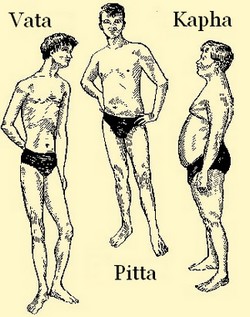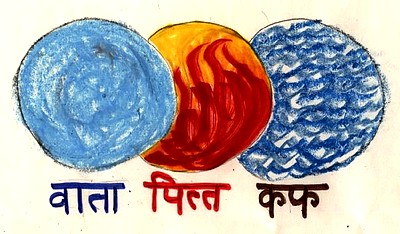In Sanskrit term “Ayurveda” means “the science of life.” This is an ancient system of knowledge about preserving and maintaining human health. Besides medical knowledge Ayurveda contains knowledge of psychology, sociology, and philosophy. This helps to obtain harmony in life, which brings happiness and real, complete health.
One of the major parts of Ayurveda science is nutrition, which is essential to our health. The majority of people have meals 3-4 times a day.
One of the specific features of Ayurveda is individual approach to every person. It is based on different types of metabolic processes in different individuals. Ayurveda identifies three such types: Vata (wind), Pitta (fire, bile), Kapha (liquid, phlegm). These types have the common term in Sanskrit – dosha. Interestingly, dosha translates as “defect” which refers to the imperfect nature of the material body.
Each dosha type can be described using three pairs of opposites:
- Cold-heat,
- Dry-wet (or oily)
- Light-heavy
For example, dryness is the main characteristic of vata-dosha, along with cold and lightness (an opposite of heaviness). These qualities will be manifested in all aspects of vata-dosha person’s life: in their physiology, in the psychological sphere, and in social activity.
 The description of a person with vata-dosha predominance: high or of a small height; slender body; dry skin; dry mucous membranes, and a tendency to constipation. Vata dosha person is prone to freeze, especially limbs; such persons are usually very creative, but lack of consistency and stability. Vata-type people are very sensitive and more that other doshas susceptible to stresses.
The description of a person with vata-dosha predominance: high or of a small height; slender body; dry skin; dry mucous membranes, and a tendency to constipation. Vata dosha person is prone to freeze, especially limbs; such persons are usually very creative, but lack of consistency and stability. Vata-type people are very sensitive and more that other doshas susceptible to stresses.
An important aspect for vata in terms of digestion is the digestive fire (Agni), which is again inconsistent and irregular in vata. Vata-type people can get carried away with something that even forget about eating. Their appetite is irregular as well.
Nutrition is directly related to digestion, so in order to make it healthier, so not only what and how we eat is important, but how the consumed food is digested, and how the waste is removed is important as well.
Ayurvedic nutrition is based on the principle of allopathy, i.e. balancing the opposite qualities. Thus, for Vata (wind) the food should bring warmness, it should moisten and make you “heavy” (to reduce the lightness of Vata). Regularity and consistence in taking meals is essential to healthy nutrition in Vata.
Pitta (fire, bile) is characterized by heat (a unique quality, which is not found in any other dosha), lightness and low moisture content. Pitta-people have average height and build, have warm skin, which is prone to irritations, and hardly bear tanning; such persons often have red or golden hair and usually do not tolerate heat.
Pitta has a good appetite, may be susceptible to diarrhea, and may have problems with liver and gallbladder. By their nature, Pitta – born leaders, they are able to lead others. If there are obstacles in their way, they tend to be angry and annoyed. Pitta’s digestive fire is strong, sometimes even excessive.
To balance Pitta dosha using the nutrition, one needs to eat cold, heavy and slightly oily foods. Full meals are especially important for them, since the missing of the one may result in an increased irritability. Generally, this type needs a lot of food (for both the body and the mind); otherwise it will digest itself, which may result in peptic ulcer disease.
Kapha dosha is characterized by heaviness (the only heavy dosha), cold and moisture. Kapha person is small in stature, but large and chunky. He or she has a tendency to excess weight. The kapha skin is soft, mist and cool, with good turgor, and a sufficient layer of subcutaneous fat.
Kapha people often have blonde hair with big curls, and blue eyes. They are unhurried, sometimes even slow. Listen more than talk, are peaceful and accommodating. They have great momentum, but are very stable in all forms. They have a moderate but steady appetite; problems with defecation are extremely rare. Rather, they are characterized by conditions associated with excess mucus in the airways and in the stomach.
Their digestive process is pretty slow and sluggish; it is important for kapha type not to overeat, and not to eat late; evening meals should be light and not later than 18:00. To maintain a healthy diet, kapha people should eat light, hot and drying food.
Ayurvedic nutrition is not so much about protein, fat, carbohydrates, vitamins and minerals, but rather about tastes. There are 6 Ayurvedic tastes: sweet, sour, salty, hot, bitter and astringent.
Six Ayurvedic Tastes
The sweet taste is found in sweet fruits, starchy vegetables, honey, milk, rice, wheat, licorice. In moderate amounts, it nourishes and strengthens the body and mind, brings stability and gives a sense of satisfaction and even love (that is why people tend to eat sweets to forget about current problems).
The sour taste is predominant in citrus, fermented milk products, other fermented foods, in unripe fruits. When taken in the proper amounts, it stimulates the appetite, improves digestion, energizes the body, awakens the mind and brings satisfaction.
The salty taste is present in different kinds of salt: sea, rock, regular table salt, and also in seaweed, such as kelp and fucus. In small doses, the salty taste improves digestion, increases appetite; in moderate doses it produces laxative effect, and in large quantities acts as an emetic.
The hot taste (gust) is in peppers, radish, onion, garlic, mustard, ginger, cloves, cinnamon, and horseradish. It stimulates, improves appetite, digestion and blood circulation, has anti-microbial effect, eliminates toxins, and brings clarity of perception.
The bitter taste is contained in a bitter melon, dandelion, and turmeric, wormwood and gentian, aloe, barberry, tansy, sorrel, and cinchona. Being tasteless in itself, it emphasizes other tastes. It has a detox effect, tones the digestive system, and reduces the amount of fat. It cleanses bodily tissues, but if taken in excess can deplete.
You can find the astringent taste in pomegranate, unripe bananas, Turkish peas (or besan), green beans, turmeric, oak bark, geranium, raspberry leaves, plantain. Astringent taste has a calming effect, dries the body’s tissues, and stops bleeding, sweating and diarrhea. It has anti-inflammatory and healing effect as well.
Ayurvedic Body Type Nutrition: How 6 Tastes Balance Doshas
Due to their properties each of the tastes has its own impact on the dosha (Vata, Pitta, and Kapha). Taste can warm and cool, moisten and make dry, make heavier and lighten.
- Sweet taste moisturizes, cools and makes heavier.
- Sour – warms, moistens and adds lightness.
- Salty taste has a warming effect, makes heavier and moisturizes.
- Hot taste has the qualities of heat, light and dryness.
- The bitter taste dries, cools and lightens.
- Astringent taste is cold, dry and heavy.
A harmonious diet should contain all six tastes, but the ratio for each dosha is different.
Balancing Vata Dosha Diet
For vata type there must be the prevalence of sweet, salty and sour tastes over the spicy, bitter and astringent tastes.
Balancing Pitta Dosha Diet
In Pitta dosha diet there should prevail sweet, bitter and astringent taste, and the sour, salty and spicy (hot) taste should not be abused.
Balancing Kapha Dosha Diet
In kapha type’s diet there should be more of hot, bitter and astringent foods, but less of sweet, sour and salty.
The proper selection of products is required to match the individual features of each dosha to help maintain good digestion, good mood and good health.

